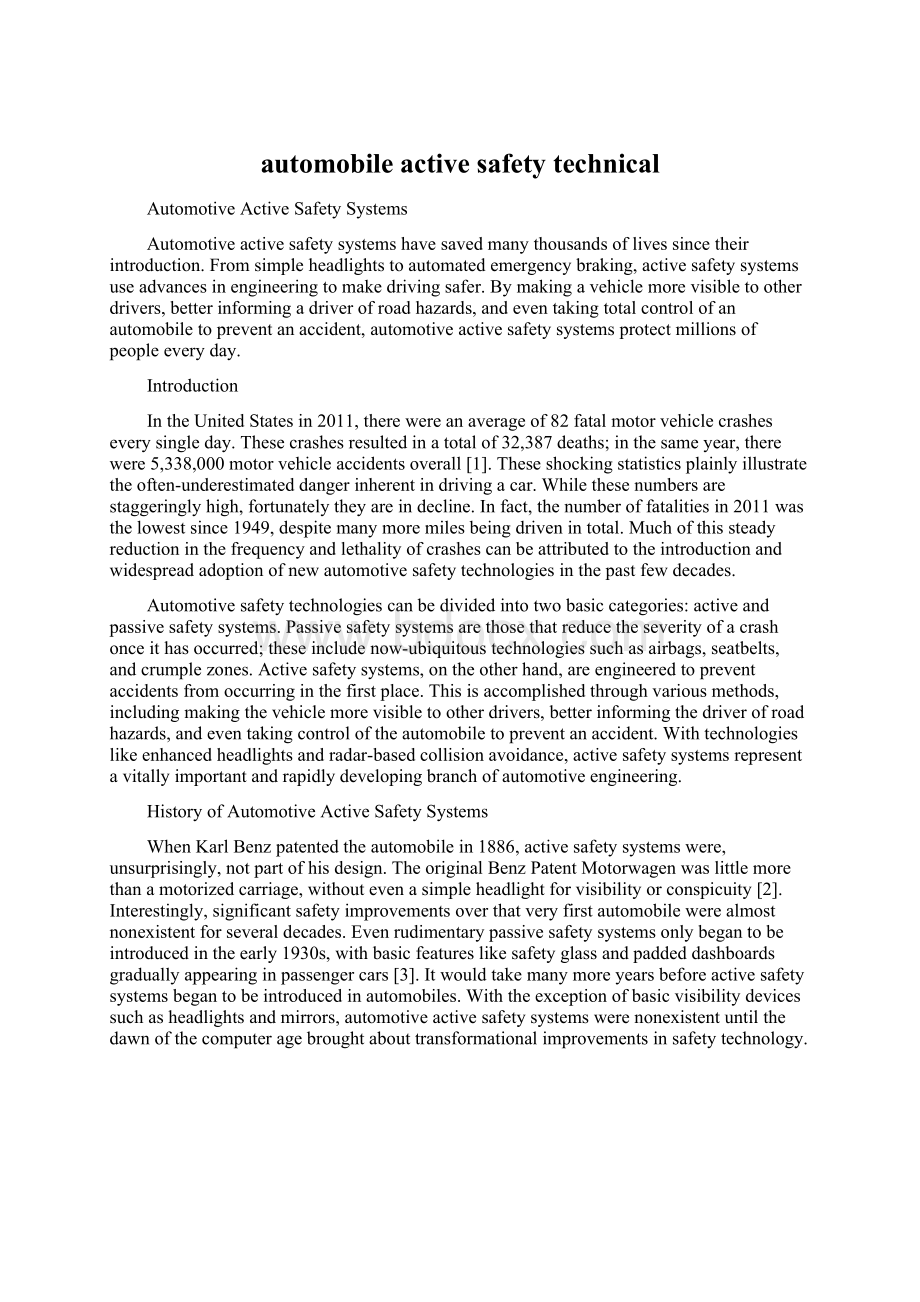automobile active safety technicalWord下载.docx
《automobile active safety technicalWord下载.docx》由会员分享,可在线阅读,更多相关《automobile active safety technicalWord下载.docx(6页珍藏版)》请在冰豆网上搜索。

Introduction
IntheUnitedStatesin2011,therewereanaverageof82fatalmotorvehiclecrasheseverysingleday.Thesecrashesresultedinatotalof32,387deaths;
inthesameyear,therewere5,338,000motorvehicleaccidentsoverall[1].Theseshockingstatisticsplainlyillustratetheoften-underestimateddangerinherentindrivingacar.Whilethesenumbersarestaggeringlyhigh,fortunatelytheyareindecline.Infact,thenumberoffatalitiesin2011wasthelowestsince1949,despitemanymoremilesbeingdrivenintotal.Muchofthissteadyreductioninthefrequencyandlethalityofcrashescanbeattributedtotheintroductionandwidespreadadoptionofnewautomotivesafetytechnologiesinthepastfewdecades.
Automotivesafetytechnologiescanbedividedintotwobasiccategories:
activeandpassivesafetysystems.Passivesafetysystemsarethosethatreducetheseverityofacrashonceithasoccurred;
theseincludenow-ubiquitoustechnologiessuchasairbags,seatbelts,andcrumplezones.Activesafetysystems,ontheotherhand,areengineeredtopreventaccidentsfromoccurringinthefirstplace.Thisisaccomplishedthroughvariousmethods,includingmakingthevehiclemorevisibletootherdrivers,betterinformingthedriverofroadhazards,andeventakingcontroloftheautomobiletopreventanaccident.Withtechnologieslikeenhancedheadlightsandradar-basedcollisionavoidance,activesafetysystemsrepresentavitallyimportantandrapidlydevelopingbranchofautomotiveengineering.
HistoryofAutomotiveActiveSafetySystems
WhenKarlBenzpatentedtheautomobilein1886,activesafetysystemswere,unsurprisingly,notpartofhisdesign.TheoriginalBenzPatentMotorwagenwaslittlemorethanamotorizedcarriage,withoutevenasimpleheadlightforvisibilityorconspicuity[2].Interestingly,significantsafetyimprovementsoverthatveryfirstautomobilewerealmostnonexistentforseveraldecades.Evenrudimentarypassivesafetysystemsonlybegantobeintroducedintheearly1930s,withbasicfeatureslikesafetyglassandpaddeddashboardsgraduallyappearinginpassengercars[3].Itwouldtakemanymoreyearsbeforeactivesafetysystemsbegantobeintroducedinautomobiles.Withtheexceptionofbasicvisibilitydevicessuchasheadlightsandmirrors,automotiveactivesafetysystemswerenonexistentuntilthedawnofthecomputeragebroughtabouttransformationalimprovementsinsafetytechnology.
D.Sikes/Flickr
Figure1:
Inrecentdecades,ABSandESChavereducedtheriskofautomobileaccidents,especiallywithdifficultroadconditions.
Madepossiblebythepoweroftheminiaturizedcomputer,theintroductionoftheanti-lockbrakingsystem(ABS)inthe1970’sandelectronicstabilitycontrol(ESC)inthe1990srevolutionizedautomobilesafety.Asoneofthefirstsafetysystemstotakecorrectiveactionandassistthedriverwithcontrollingthevehicleinunstablesituations(likepoorroadconditionsrelatedtoweatherasinFig.1,forexample)ESChadanespeciallysignificantimpact.TheInsuranceInstituteofHighwaySafety(IIHS)foundthatESCreducestheriskofsinglevehiclecrashesby40%,andreducestheriskoffatalcrashesbyamassive56%[4].Thesefiguresshowthetremendousimprovementthatactivesafetysystemsoffer,evenincarsalreadyprotectedbypassivesafetysystems.However,assignificantastheseadvanceswere,theyonlyrepresentthebeginningofthedevelopmentofactivesafetysystems.Newtechnologiesadoptedinthelastdecadeareonceagaincausingaparadigmshiftinautomobilesafety,affecting–andpotentiallysaving–thelivesofdriversaroundtheworld.
SituationalAwareness
Improvingthedriver’sawarenessofroadhazardsisthefoundationofsafedriving.Ifadriverisnotinformedquicklyofpotentialdangers,reactingappropriatelytothembecomesmoredifficultandtheprobabilityofanaccidentoccurringrisesdramatically.Sinceimprovingthedriver’sabilitytoanticipatedangerhassuchpotentialtoreducethefrequencyandseverityofaccidents,someofthemosteffectivemodernautomobilesafetytechnologiesfunctionbyenhancingthedriver’ssituationalawareness.
AdaptiveHeadlights
Ironically,oneofthemosteffectiveactivesafetytechnologiesemployedinvehiclestodayisbasedonthemostbasicofactivesafetydevices:
theheadlight.Alongwithmakingthevehiclehighlyvisibletootherdrivers,headlightsserveasimplepurpose:
illuminatingtheroadaheadatnight.However,standardheadlightsonlylightuptheterraindirectlyaheadofthecar;
thereisanunavoidablereductioninvisibilitywhendrivingintoacurve(Fig.2)asthelightpointsuselesslyofftheoutsideofthebend.Thislossofvisibilitycanleadtoadangeroussituationifthereisanobstacleinthecurvethatisnotilluminatedintimeforthedrivertoreact.
SebastianBallard/geograph.org.uk
Figure2:
Narrow,curvedroadscanposegreatdangertothoseautomobilesnotoutfittedwithadaptiveheadlights.
However,automakershavedevisedaneffectivesolutiontothisdangerousshortcoming:
adaptiveheadlights.Adaptiveheadlightsturntoilluminatethevehicle’spathwheneveritturns,allowingthedrivertoseeintocurveswhendrivingatnight.Thisisaccomplishedbyhousingtheheadlightinanassemblythatcanberotatedhorizontallybysmallelectricmotorstopointtheheadlightsinthevehicle’sdirectionoftravel.Byrapidlyprocessinginformationsuchassteeringwheelangle,yaw,andthespeedofthevehicle,adaptiveheadlightscananticipatewherethecarisgoinganddirectthelightaccordingly.Adaptiveheadlightsanticipatethepathofthevehicleandturntoilluminatecurvesintheroadahead.
Whilethisimprovementinvisibilitymayseemminor,real-worlddataindicatesthatadaptiveheadlightsareahighlyeffectivesafetyfeature.InastudyconductedbytheIIHS,adaptiveheadlightswereresponsiblefora10%reductioninaccidentsincarsequippedwiththem[5].Ifeverycarontheroadwereequippedwithadaptiveheadlights,approximately142,000crashescouldbepreventedeveryyear[6].Clearly,theimprovementinvisibilityhasasignificantpositiveeffectonsafety,butadaptiveheadlightsonlyworkatnight.Otheractivesafetysystemsmustbeutilizedtowarndriversofthehazardsthatcanescapetheattentionofadrivereveninbroaddaylight.
BlindSpotInformationSystem
Avehicle’sblindspotrepresentsatreacherousgapinadriver’ssituationalawareness.Theblindspotisdefinedastheareaaroundthevehiclethatisobscuredfromthedriver’sview.Inpassengervehicles,thisismostcommonlythehiddenareathatliesbetweenthefieldofviewoftherearviewmirrorandsideviewmirrors.Ifadriverisunawarethatthereisanothervehiclehiddeninthecar’sblindspotandchangeslanessuddenly,acollisionislikelytoresult.Arecentlydevelopedprotectionagainstthisthreatistheblindspotinformationsystem(BLIS).Thisactivesafetysystemusescamerasonthesideofthecartodetectthepresenceofothervehicleswithinthecar’sblindspotandalertsthedrivertotheirpresencewithawarninglightonthecorrespondingsideofthecar.Ifthedriveractivatestheturnsignalonthesideofthecarwheretheunseenhazardislurking,amoreintrusiveaudio,visual,orhapticwarningisissuedtourgentlydiscouragethedriverfromchanginglanes.
Theblindspotinformationsystemisavaluableadditiontothedriver’sownvisualinspectionofthesurroundingroad.However,asusefulaswarningtechnologieslikeBLIScanbeinpreventingaccidents,anewgenerationofactivesafetytechnologiesaimstomakedrivingsaferthaneverbycorrectingforthevehicle’smostunreliableelement:
itshumandriver.
DriverAssistance
Technologiessuchastheblindspotinformationsystemandactivesteeringheadlightscertainlymakedrivingasaferendeavor,buttheyhaveamajorshortcoming;
thedriveralonebearstheresponsibilityfortakingactiontoavoidadangeroussituation.Whilekeepingdriversinformedoftheirsurroundingsontheroadmakesavitalcontributiontosafety,humanerroroftenresultsinanaccidentdespitethefranticwarningofactivesafetysystems.Thisistheimpetusbehindtheriseofdriverassistancesystems:
technologiesthatnotonlywarnthedriverofhazards,butalsohavethecapabilitytotakepartialcontrolofthevehicletopreventacollision.
CollisionAvoidanceSystem
Rear-endcollisionsarethemostfrequentlyoccurringtypeofaccident,andtheyarealsoofteneasilypreventable[7].Inmanycases,adistracteddriverwillsimplyfailtonoticethattheleadingcarhasslowedorstoppedandcrashintoit,whichcouldbedeadlyforeitherdriverinvolvedatsufficientspeeds(Fig.3).Thetechnologythatwasdevelopedtopreventthisisknownasthecollisionavoidancesystem.Collisionavoidancesystemsutilizearadarunitmountedinthefrontofthevehicletotrackthedistanceandspeedoftheleadingcar.Iftheradarsensesthattheleadingcarisslowingrapidly,awarningwillsoundtoencouragethedrivertobrake.Ifnoactionistakenandthedistancebetweenthetwovehiclesisdecreasingquicklyenoughtomakeanaccidentinevitable,thesystemwillautomatica